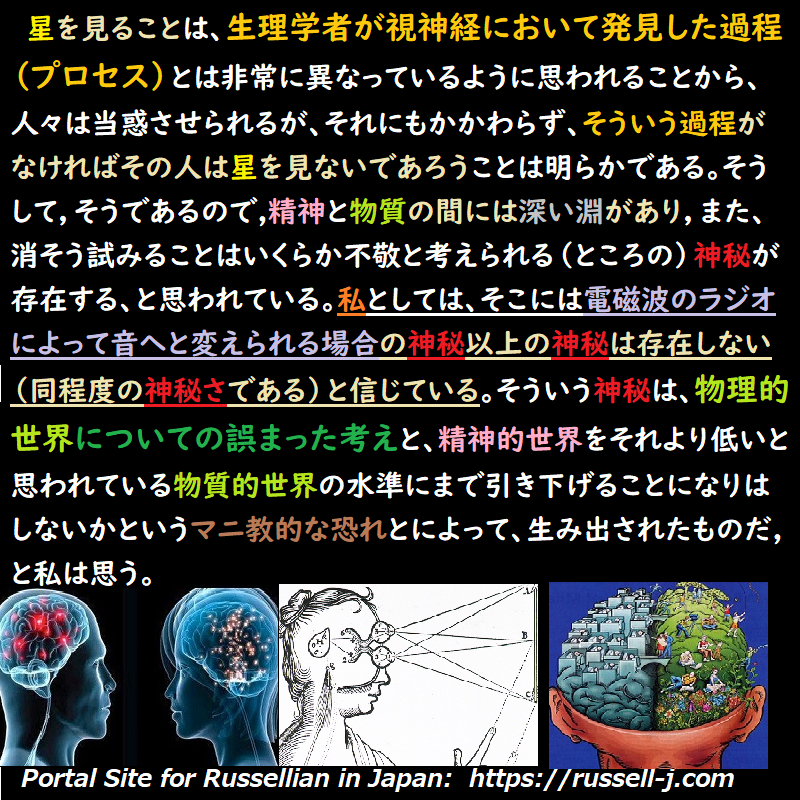事象(出来事)がもはや(世界の)究極の素材ではない(ところの)さらに進んだ分析の段階の可能性がある(さらに分析を進めると事象(出来事)がもはや世界の究極の素材ではないという可能性が存在している)。しかし,私はそれについてはここでは論じないことにしよう。 星(恒星)が発する光がその星からあらゆる方向に進むにつれて、純粋に物理的な理由により、多くの異なる時間と場所における事象(出来事)がしばしばまとめられて(言わば)一人の祖先から出た(多くの)家族とすることができる(can often be collected into families )のを(これまで)我々は見てきた。そういう一つの家族のひとつの枝において連続する(連続して現れる)諸世代は、状況に従って,様々な程度を示す相似性をお互いに持っている。星から我々(地球)の大気に至る光の移動(the journey 光の旅)を形成する多くの事象(出来事)は、ゆっくりしておりほとんど変化しない(change slowly and little ゆっくりとわずかだけ変化する)。そして,それがそれらの事象(出来事)を持続するものと考えてもよい、光子(photon)と呼ばれる単一の実体の航海(voyage 移動)とみなすことを可能にするのである。しかし、光が我々(地球)の大気に到達すると、一連のより不思議なこと(odder and odder things)がその光(光子)に連続的に起りはじめる。すなわち光は霧や雲によってさえぎられたり変形させられたりするかも知れない(可能性がある)。また光は水面に当り,反射したり屈折したりすることもある(かも知れない)。またそれは写真乾板に当って、天文学者の興味をひく黒い点となることもある(かも知れない)。最後に、光はたまたま人間の眼に当ることもある(かも知れない)。このことが起ると(人間の目に光があたると)、その結果(生ずること)はとても複雑である。(人間の)眼と脳との間には、生理学者によって研究されている一連の事象(出来事)が存在しており、それは、電波(radio waves)が演説者の言葉に似ていないと同様に、外界(outer world 外部世界)の光子と似ていない。ついには,生理学者によって追跡される神経の撹乱は最終的に脳内の適切な領域に到達し、その後、その脳を持つ人(その脳の持ち主)がその星を見る(ことになる)。星を見ることは、生理学者が視神経(optic nerve)において発見した過程(プロセス)とは非常に異なっているように思われることから、人々は当惑させられるが(当惑するが)、それにもかかわらず、そういう過程(プロセス)がなければその人は星を見ないであろうことは明らかである。そうして,そうであるので,精神と物質の間には深い淵があり,また、消そう試みることはいくらか不敬と考えられる(ところの)神秘が存在する、と思われている。私としては、そこには電磁波のラジオによって音へと変えられる場合の神秘以上の神秘は存在しない(同程度の神秘さである)と信じている。そういう神秘は、物理的世界(物的世界)についての誤まった考えと、精神的世界(精神世界)をそれより低いと思われている物質的世界の水準にまで引き下げることになりはしないかというマニ教的な恐れとによって、生み出されたものだ,と私は思う。
Chapter 2: My present view of the world, n.7
There is a possibility of a further stage of analysis in which events are no longer the ultimate raw material. But I will not consider this in the present discussion. We have seen that, for purely physical reasons, events in many different places and times can often be collected into families proceeding from an original progenitor as the light from a star proceeds from it in all directions. The successive generations in a single branch of such a family have varying degrees of resemblance to each other according to circumstances. The events which constitute the journey of the light from a star to our atmosphere change slowly and little. That is why it is possible to regard them as the voyage of single entities called photons, which may be thought of as persisting. But when the light reaches our atmosphere, a series of continually odder and odder things begins to happen to it. It may be stopped or transformed by mist or cloud. It may hit a sheet of water and be reflected or refracted. It may hit a photographic plate and become a black dot of interest to an astronomer. Finally, it may happen to hit a human eye. When this occurs, the results are very complicated. There are a set of events between the eye and the brain which are studied by the physiologist and which have as little resemblance to the photons in the outer world as radio waves have to the orator’s speech. At last the disturbance in the nerves, which has been traced by the physiologist, reaches the appropriate region in the brain; and then, at last, the man whose brain it is sees the star. People are puzzled because the seeing of the star seems so different from the processes that the physiologist discovered in the optic nerve, and yet it is clear that without these processes the man would not see the star. And so there is supposed to be a gulf between mind and matter, and a mystery which it is held in some degree impious to try to dissipate. I believe, for my part, that there is no greater mystery than there is in the transformation by the radio of electro-magnetic waves into sounds. I think the mystery is produced by a wrong conception of the physical world and by a Manichaean fear of degrading the mental world to the level of the supposedly inferior world of matter.
Source: My Philosophical Development, chap. 2,1959.
More info.:https://russell-j.com/beginner/BR_MPD_02-070.HTM

